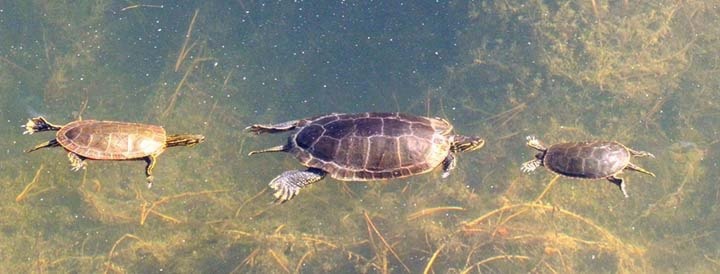As the seasons turn from summer to fall and look ahead to winter, the situation at Idlewild Lake remains in stasis as the city struggles to work towards a solution to fix the dam.
Idlewild Lake, which has been partially drained in order to relieve stress on the dam prior to its decommissioning, has been a point of concern for Cranbrook residents worried about the draw down effect on the ecosystem. The lake is home to Western Painted Turtles and serves as nesting grounds for migratory birds and other aquatic and amphibious life.
However, reinforcing the dam and restoring the lake back to what it was is proving to be a daunting challenge, according to Eric Sharpe, the Director of Engineering and Development Services.
"The whole drawdown was strictly an interim measure to satisfy [provincial regulations] while we jump through all these other hoops, and now it looks like it's going to be a very lengthy process as far as fish, turtles and birds, and anything else that may crop up," Sharpe said.
"We're just in a wait-and-see mode right now. We've got an application in for funding from the other two levels of government, but as of today we haven't really heard anything — so everything is kind of on hold."
Sharpe said the City has received permits for the fish work that needs to be done, but that work will not end up being done this year. “One, we're outside of the fish window now and two, it's just doesn't make any sense at this stage, really not knowing how things are going to proceed.”
Sharpe said that as an example. the window for working with the turtle population doesn't coincide with the window for working with fish or for nesting for migratory waterfowl.
“So, we're kind of between a rock and a hard place, to be honest."
Cranbrook's populations of western painted turtles (Chrysemys picta bellii) are unique — they are the most northerly occurring turtles in North America, and the only native pond turtle left in B.C. The Kootenays are the northern-most extent of their range.
They are also considered a species at risk, and are on the Provincial Blue List which confirms that status.
In winter, the waters of their ice-covered ponds are generally about 2°C and their metabolic rate is extremely low. This allows them to survive months of hibernation by relying on anaerobic metabolism (metabolism without oxygen), supplemented with some direct uptake of oxygen through specialised gill-like tissues around the cloaca (the common opening of the reproductive and digestive tracts).
In February, City council made an in-camera decision to decommission the Idlewild Dam and draw the water level down in response to a report that identified concerns over its structural integrity.
Mayor Lee Pratt at the time said the decision was based on a Dam Breach Inundation Study, which noted if the dam failed, the uncontrolled release of water from Idlewild Lake would follow Joseph Creek through town and potentially flood up to 21 per cent of the city. That could impact as many as 2,100 residential properties and nearly 500 businesses. The report noted there was also potential for loss of life.
The lowering of water levels in the lake would facilitate the decommissioning of the old dam and the establishment of a new dam, a restored lake and rehabilitated spillway system, Pratt said at the time.
Since then, the area around the lake has been fenced off and water levels have receded, which has raised concerns about the habitat of the Western Painted Turtles and other flora and fauna around the area.
Sharpe notes that because of regulations from provincial and federal levels of government, it's been frustrating to try and do the necessary work to help the turtles, birds and fish.
For example, simply relocating the turtles to another lake isn't as simple as it sounds, he said.
"What we're being told is we have to basically radio-tag and capture five turtles and look at relocating them somewhere else and see if they will over-winter and survive there before we can do anything with any of the other turtles," Sharpe said. "And it has to be moved to a location where there are no turtles and there's very few of those around and we have to monitor the turtles for a year to see how they do."
Idlewild dam was built in the 1930s and is an earth-fill dam with a concrete core. The city said the dam is classified as a very high consequence dam by the Ministry of Forests Lands and Natural Resource Operations. That was confirmed in the Dam Breach Inundation Study, completed by Urban Systems in 2014.
